In this step-by-step complete guide, I will show you how to improve your eCommerce link building (offsite-SEO) and get more sales.
If you haven’t yet checked part 1 – Advanced SEO for E-commerce complete guide, I encourage you to check it. That’s because you will rank way easier if your onsite SEO is on top.So, you got your online store up and running. Great! Now it’s time to get some traffic and make some sales.
But let’s face it – getting traffic is hard. It doesn’t have to be.
I’m going to share the exact eCommerce link-building tactics that helped me improve my search engine rankings, increase my traffic, and grow my store’s sales.
But first, let’s get something out of the way:
If you are here to learn fast link building, you’re in the wrong place.
Link building is a growth strategy that requires significant time, investment, and effort on your side.Prepare yourself to do a lot of work but trust me. All the efforts will be worth it in the end as you will see yourself ranking for the keywords you want and generate sales.
Table of Contents
Scaling growth is hard – there are only a few ways to do it. As Andrew Chen says, there are only a few ways to scale user growth. In my opinion, this applies to eCommerce traffic and sales, too.
These ways are Paid acquisition, Virality, SEO.
Each of these channels creates exponential growth because when you make money from customers, you can use that money to buy more customers, which gives you more money.
In the virality scenario, a cohort of new users will invite even more users, who then invite even more on top of that.
#1.1. Paid acquisition for eCommerce
If you are aware of the Lean Startup, you’ve validated the demand for the things you sell by now. During the validation stage, it’s likely that you used paid channels to get that initial boost in your traffic and acquire your first customers. Using Google Ads (AdWords), as StartupBros suggests, is a quick way to validate your business idea on the cheap.
Yet:
The paid acquisition might not be the perfect solution for your online store in the long term. Buying customers directly through ads will cut your already razor-thin eCommerce margins.
If you are in a dropshipping eCommerce business, you likely have a 5 to 20% product margin on your sales.
Make this simple calculation:
How much it costs you to acquire a paying customer through Google Ads (or other paid acquisition channels)? And what are the return on investment (ROI) per paying customer and the customer lifetime value (CLTV)?
With my store, it cost me roughly $30 to get a paying customer through Google Ads. And the (Customer Life Time Value) CLTV was below that. I was losing money. Not good!
#1.2. Virality for eCommerce

If you have an innovative, unique, custom-made product, a la Kickstarter, viral word of mouth could work for you. Also, you can achieve virality with a good marketing strategy. And for some, it did work. (Hint: TheDollarShaveClub.)
But what if you are selling a commodity?
Would your friends love the office supplies you sell so much to share them with the whole wide web? Yeah, that’s what I thought.
Even if you produce a unique product, you still need to design your viral loop and have a viral engine in place. Think here lots of A/B testing and experiments.
#1.3. Improve your store’s SE rankings and sales with SEO
There’s no doubt that you can get more sales for your online store and improve your search engine rankings by doing off-page SEO. e-Commerce link building in particular.
Let me show you:
Brian Dean of Backlinko shares how one of his readers managed to increase his online store’s referral traffic by getting quality backlinks:

We managed to get almost 3,000 organic traffic sessions at our Bulgarian store for three months, just a month after our launch. Keep in mind that we are using a brand new domain for the store.
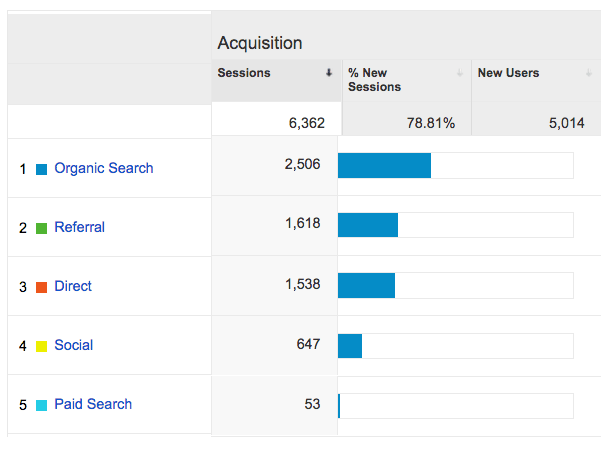
Also, about 80% of our referral traffic is coming from our link-building efforts.
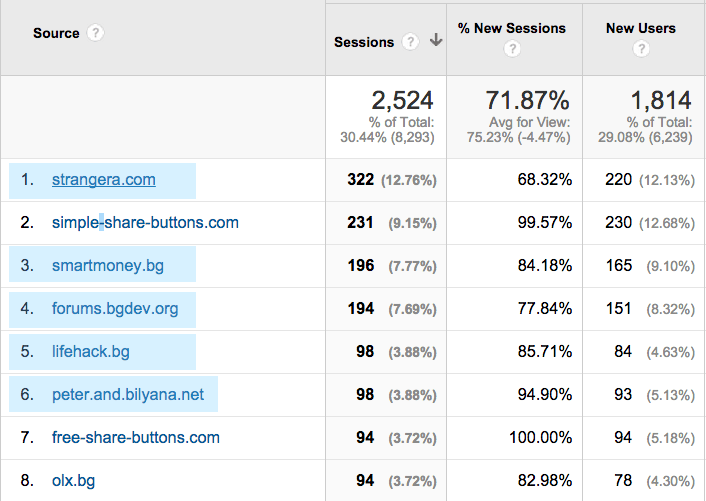
Moreover, SEO is our top revenue source and top orders source:
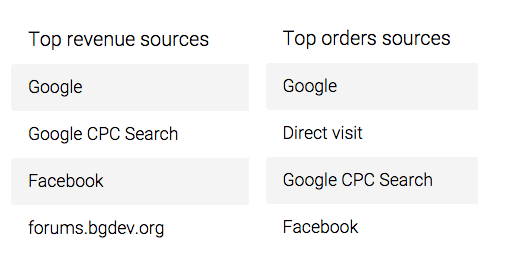
This result is the outcome of just about a couple of weeks of link building.
Benefits of SEO link building for eCommerce:
- You pay with your sweat. Perfect for bootstrapped stores.
- Your product margins won’t shrink like the stock market.
- It’s scalable.
- If targeted correctly (keywords with buying intent), it brings people who intend to purchase.
Drawbacks of SEO link building for eCommerce:
- If not done well, Google might penalize your store. Do I have to say no paid links?
- There’s no such thing as “fast link building.” Getting quality backlinks to your store takes effort and a lot of hustling.
This post is a comprehensive guide to off-page link building for eCommerce. Use it and apply it today to improve your store’s search engine rankings.
I’m going to share with you my best actionable advice on link building for eCommerce:
#1.4 Is your Store Link-Worthy?
The web is built on links, right? But what motives a site owner to link to your shop.
Here’s the deal: Nobody cares about your online store.
The sooner you get used to this, the sooner you’ll become better at link building.
People care all about: Them, them, them.
Be useful!
The less valuable your content, The less likely you are ever to receive a link to it. – Eric Ward, author of “Ultimate Guide to Link Building.”
Ward continues by saying that the most useful sites provide rich quality content on a particular subject on which the author is an authority.
Imagine you sell supplements. The supplements market is a competitive one.
What most store owners do when they launch their online store:
Take the default distributor’s product copy and pictures and throw it on a basic product page with a “Buy now” button. While that approach might be fast, it’s not the best way to be useful and get people to link to your online store.
On the opposite, check what Bodybuilding.com is doing for their product pages:
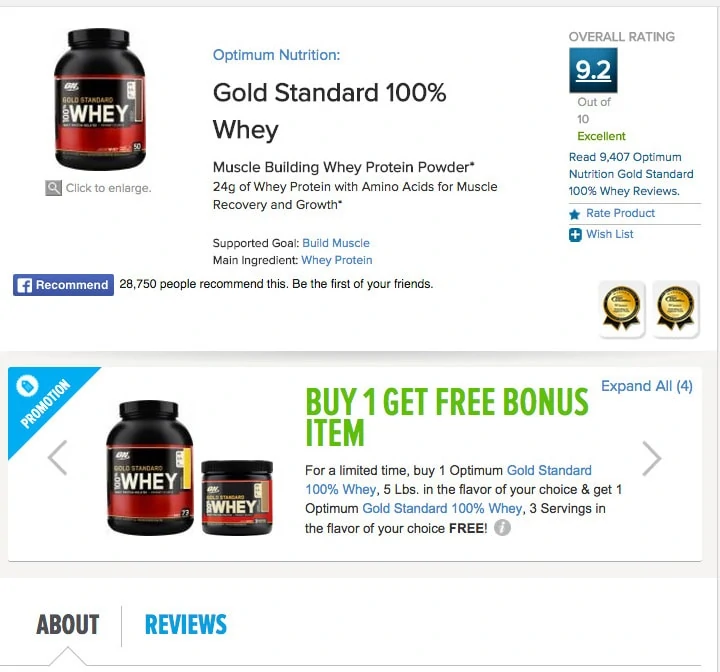
Gosh, so much useful information!
There are tons of content on every facet of this product. The whole page is using a custom-built design that looks like a magazine review. There’s info on the servings, tastes, way of consuming, ingredients, and loads of customer reviews. It could be the best resource on the web about this whey protein.
Bodybuilding.com is an excellent example of how an online store can add rich, relevant content and build a community around its products. Also, make sales along the way.Getting links naturally will decrease your manual link-building efforts.
In a webinar, Rand from Moz, which we interviewed a while ago here on Monetize.info, talked about the importance of being link-worthy and likable.
The process of link building today has reversed.
You don’t build links anymore; you earn links naturally.
If you can’t earn links naturally, not only can you not get links fast enough and not get good ones. You probably earn links that Google doesn’t even want to count or may even penalize you for. It’s nearly impossible to earn links with just good, unique content.
Rand Fishkin “Why Good Unique Content Needs to Die.”
The 10x concept is not something new.
In one of his latest lectures, “Competition is for losers,” Peter Thiel (founder of Paypal) said that to conquer a market, you must be 10x better:
My sort of crazy, somewhat arbitrary rule of thumb is that you want to have a technology order of magnitude better than the next best thing. So Amazon had over ten times as many books, it may not have been that high tech, but you figure, oh well, it can sell ten times as many books and be more efficient along the way.
Peter Thiel
For MenGear, we hired a junior copywriter to write unique product descriptions for every product on the site. Because the products we sell are hard to find on the local market, it was easy to create unique product descriptions.
The least words per product copy were 300 words. That way, we had over 200 hundred web pages of unique product copy.

We still have to work on achieving the 10x effect!
Before creating your link building campaign, you should ask yourself:
- Are my product pages 10x better than my closest competitor?
- Are my product descriptions 10x better than my closest competitor?
- Is my product photography 10x better than my next best competitor?
- Is my store genuinely useful for my customers?
- Is the UX of my online store 10x better than my competition’s store?
Being useful gets you backlinks and makes your store grow. Products don’t.
#1.5 Is link building dead?
While I had my best results with off-page SEO, a more increasing trend improved your site’s user experience.
How to measure UX when it comes to SEO?
- CTR (click-through rate) – what % of people click on your store on the search engine results page (SERP). CTR indicates how relevant are your pages to the people searching for a particular term. With online stores, people usually search for a product. They either are looking for information about the product or are using a long-tail keyword when they have a buying intent.
- Time on site – your visitors should stay on your site for more than a minute. Include interlinking sections like “Relevant products,” “Product Reviews,” “Users also bought,” etc. These sections can increase customers’ time on your site and general engagement with your products. Amazon is an excellent example of this. They are pretty good at making you spend more time (and money) on their site:
- Bounce rate – In your Google Analytics, go to Acquisition > All traffic > Source/medium and select Organic. What’s your bounce rate?
- Personal experience note: When we raised our product prices, we significantly increased the organic traffic’s bounce rate (as you can see). Why? Because our prices didn’t meet the people’s expectations. People could see the price discrepancy when comparing our product’s prices to the prices of other stores they found on the SERP. Our prices were way off!
As Neil Patel puts it in this post about UX: What’s best for users is best for Google.
See:
I still believe off-page link building will get you lots of traffic, and sales bud, don’t abandon your on-page UX metrics. Also, make sure to get your pricing right. That way, your search engine rankings will undoubtedly improve.
Okay, your product pages are in check, and you’re confident with the UX you deliver to your store.
What’s next?
#1.6 What’s your link-building campaign goal?
Before you dive deep into designing the link-building campaign for your online store, you must decide on your primary goal. Choosing your campaign goal will allow you to be more analytical and track the right metrics for your link-building efforts.
Example goals could be:
Goal #1: Getting more online sales
What to measure on your online store?
- The number of orders made through Google organic traffic.
- Revenue from Google organic traffic.
- The conversion rate for that traffic channel – what number of people from Google bought a product.
For points 1 and 2, I’d like to use a simplified analytical software for eCommerce called Metrilo. Metrilo integrates with your online store and allows you to see an overview of your top revenue and order sources neatly:
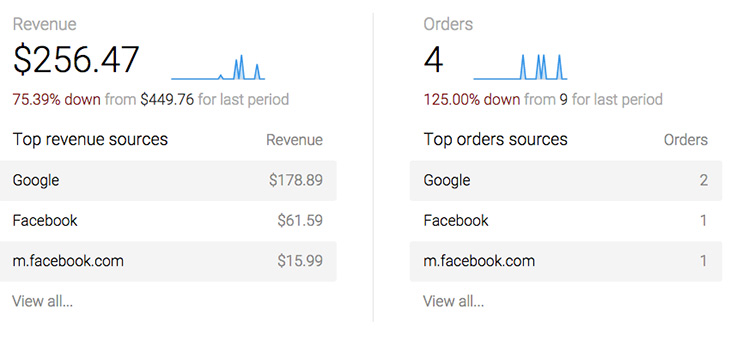
A free alternative (although not as simple and well detailed as Metrilo) is setting up a goal in Google Analytics.
What to measure on the SERP (Search Engine Rankings Page)?
- Your search rankings for a particular converting keyword. That usually is a long-tail key term that lands the searcher on one of your product pages. I like this little free tool that shows your SERP position based on a keyword and domain:
- Increase in converting search traffic.
Goal #2: Increasing your store’s authority and trustworthiness
You can improve your eCommerce authority by getting links from sites that have already earned the public and search engines’ trust and proven authority.
Although the SERP impact is significant, in this case, a strong side-benefit is your online store’s increased value in the market.
Imagine you sell geek gadgets, and your store gets a positive review on another geek blog. Your online store will likely receive some healthy referral traffic and site engagement.
What to measure in your online store?
- Increase in referral traffic.
- The conversion rate increase for the referral traffic channel.
- Increase of newsletter/other opt-in subscriptions.
- Increase of product reviews, blog comments, and other site engagement metrics.
- Decrease of bounce rate. Notice how low is the bounce rate for our referral traffic result of the link building campaign:
- Increase of other sites actively suggesting your products.
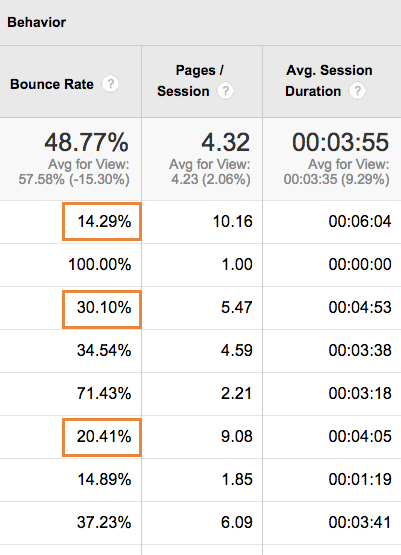
What to measure on your SERP?
- Increase of branded searches.
- Increase in your search engine rankings.
Once you know your primary goal and how to measure it, it’s time to get your hands dirty and build your link-building eCommerce campaign.
Why creating an “eCommerce link building Campaign” is the wrong way to go?
Because:
Good marketers think of campaigns. Great marketers think of frameworks. I learned this from Quicksrpout’s guide to online marketing.
Look:
When a campaign ends, the backlinks to your online store stop. And you don’t want that!
You should create something repeatable. You must design a system and repetitive processes that help you build ongoing relationships for link building.
That’s why we will not create a link-building campaign but a framework that would allow us to produce sustainable results on that scale.
#2. Scalable growth with a Link Building Framework
Let’s get our feet wet!
2.1 What’s the Link Building Framework?
The eCommerce Link Building Framework is the document you should be referring to time and time again while executing any link building.
This Link Building Framework can be used for any link-building campaign, not just for online stores. It’s our tactical blueprint for backlinking and also a simple CRM.
What to do next?
- Start by creating an excel spreadsheet. If you are collaborating with team members, you might want to create a Google spreadsheet.
- Name it “[your store’s name] Link Building Framework.”
- Add the following columns. We are going to explain each column in detail below: Website, Rapport Built, Contacted, Replied, Linking, Contact details, Asset type, Article name (if applicable), Audience, Most used keywords, Backlinks profile, TF (Majestic), PA, DA, Traffic (optional), Conversion rate (optional), Number of orders (optional), Revenue (optional)
This is how the link-building framework for my online store looked like. Click on the image to view full-size.
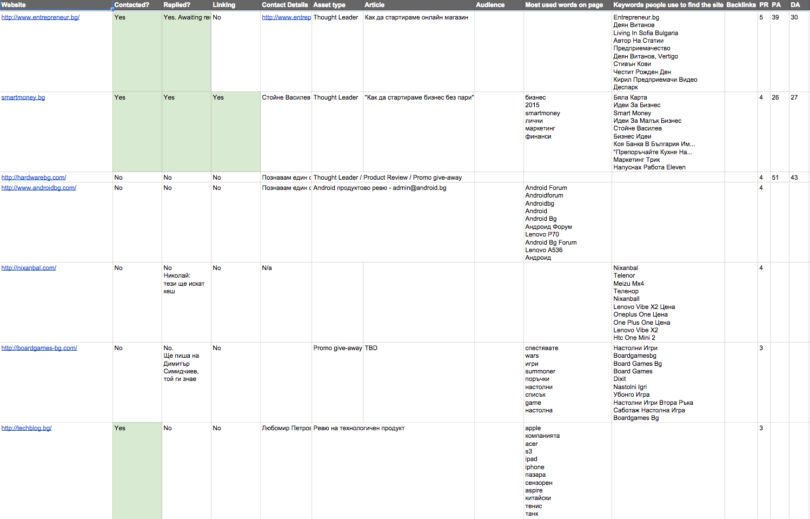
Link building framework columns:
- Website – the link opportunity. A concrete URL that you’d like to backlink to you. It could be a top-level domain name, a sub-domain, or an inner page. Read the “Find Link Opportunities” section to learn how to find sites.
- Rapport > Contacted > Replied > Linking – Yes/No; for each column. These columns represent the “backlinking relationship funnel.” They help you keep track of every relationship:
- Contact Details – Name, email, phone, etc.
- Asset type – your linkable assets. Promotions, giveaways, discounts, products, expert opinions, and any other assets related to your online store. More on assets in the “Figuring your linkable assets” section.
- Article name – if you are doing guest-blogging.
- Audience – an overview of the audience that read the website or a particular page on the website.
- Most used keywords – most used key terms on that website, domain name, or page.
- Backlinks profile – What website link to the link opportunity page. A linking profile of the website. Read more about qualifying link opportunities in the “Identify Good And Bad Links.”
- TF – Trust Flow, metric from Majestic.
- DA – Moz Domain Authority.
- PA – Moz Page Authority.
- Traffic – measure the referral traffic that came as a direct result of your backlink.
- Conversion rate (CR) – what % of people who came from the link made a purchase. CR will help you better understand what web pages to target if your main goal is getting more sales.
- The number of orders – how many orders did you get as a direct result of that backlink.
- Revenue – revenue as a direct effect of that backlink. It is beneficial if you’re investing in your linking assets. That way, you can measure ROI.
2.2 Make an inventory of your linkable assets
Why should people link to you? Your linkable assets answer.
Your linkable assets are something that only you have. They should be different from other websites. I’ve identified some common linkable asset categories to help you get thinking about what your online store’s linkable assets could be.
2.2.1 Content assets
As Kerry from GetResponse says in this article: It’s becoming an age-old adage already, but, more and more, it is proving to be true again and again – content is king. The most valuable links are the organic ones, and the best way to build those is to continue to create the very best content that you can and get it shared far and wide across social and in your email campaigns.
Content assets open up your store to a lot of link opportunities. Also, content assets are again about being useful and helping people solve their problems.
When you think of content assets, don’t just think of text.
Examples of Content assets for your online store:
- Detailed product descriptions. Over 600 words. Your product copy should be unique, helpful, and evoke emotions.
- Videos – how-to video guides, product reviews, and other videos showing the product in use.
- FAQs – install Disqus or Facebook comments on your product pages and collect customer’s questions. Then organize the most common ones into a product FAQ.
- eBooks – technical guides and product brochures.
- Illustrations – help people to understand your product better with useful illustrations and diagrams.
- 360-degrees product photos – allow people to interact better with your product online. [WooCommerce 360 Image] is a great plugin that allows you to implement interactive 360-degree images on your product pages.
Think Geek is an excellent example of an eCommerce site that creates many content assets on its product pages.
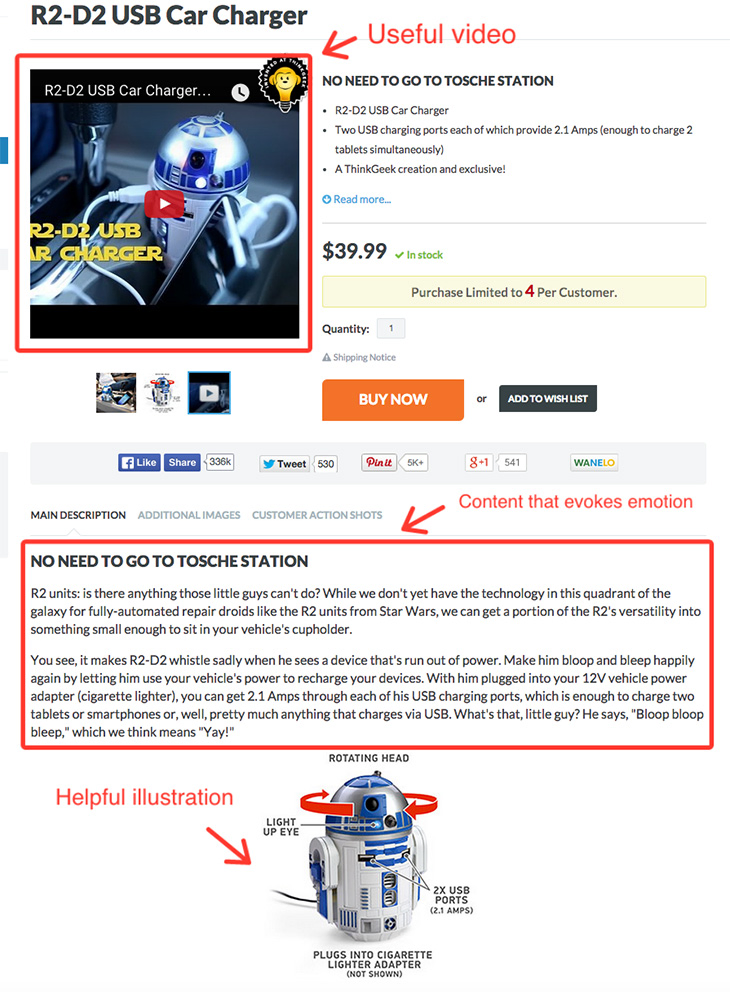
2.2.2 Product assets
Because you are an online store, often, this is your best linkable asset. It might also be the easiest path to get some quality backlinks.
Depending on your product prices, you can use this asset for giveaways, donations, promotions, reviews, and contests. Just be careful not to go over overboard, or you might lose more money than you earn from this tactic.
2.2.3 Knowledge and opinion assets
AKA the “thought leader” link-building tactic.
Share your field expertise with the community through guest authoring, posts, and interviews.
Apart from being a reliable approach for quality link building, this method develops your authority in the domain of your store.
2.2.4 Collaboration assets
Create partnerships with your suppliers, customers, authority figures in the field, and PR resources. You can later leverage these relationships to create link-building opportunities.
2.3 Make a list of your assets
You will input this information under “Asset type” on your Link Building Framework file.
- Content assets: product descriptions (300+ words), FAQ on each product page, 3 blog posts a week on innovation, technology, and geeky stuff.
- Product assets: 10% off on all products, 20% off on Star Wars product category.
- Knowledge assets: articles on eCommerce, Entrepreneurship.
- Partnership assets: connect with eCommerce marketplaces.
Once you start link building, you should identify which assets bring you the most links. In your link building framework doc, just click on the “Asset type filter” and filter the different types of assets.
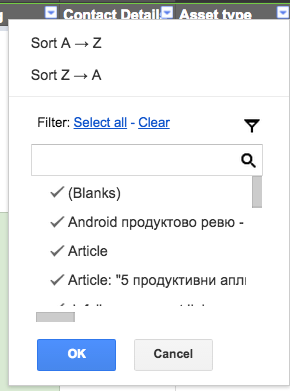
Then focus on what works best by trying to generate links using those particular assets.
#3. How to find link opportunities
Now it’s time to find websites and pages that are most likely to link back to your online store. You either are going to find them manually or extract link opportunities via data scrapping.
Collect all website links under the “websites” column on your link-building framework.
Here are 5 methods to find link opportunities for your store:
3.1. Look for blogs in your field
Let’s say you sell geek gadgets. The best way to find geeky blogs is to look for blog lists and content curators.
You can do a quick search to find publishers that write about geeky things by using queries such as:
- geek + “blogs.”
- geek + “top blogs.”
- geek + “list of blogs.”
- geek + “favorite blogs.”
- geek + “posts.”
- geek + “post roundup.”
- geek + “news.”
Check this great post from Buzz stream on finding content curators. Extracting dozens of URLs from list pages might be a tedious job to do by hand.
Link Gopher is a handy-dandy little Firefox extension that extracts all links from a page and removes duplicates for you:

A great tool I recommend for finding link opportunities on related blogs for your e-commerce website is Link-Assistant from SEO Power Suite.
You can outsource the link-building efforts by using one of the best link building services we reviewed.
3.2. Look deep for forums, directories, and communities
You should know where your target audience hangs out. Identify a list of niche websites and social networks.
When thinking about your audience, don’t just think about your market-defining audience.
Let’s say you sell teeth whitening kits. Your initial instinct might be to think about people with teeth problems or self-conscious people.
If you think more creatively, you may expand that search to other people who are likely in need of teeth whitening. For example, people who will get married soon, graduating students, YouTubers.
For my gadget store, I targeted not only geeks but web developers and entrepreneurs.
Use search queries to identify communities where your audience hangs out:
- [my target audience] message boards
- [my target audience] communities
- where [my target audience] hangs out
- where to find [my target audience]

Again here, you can get a hand of help from Link-Assistant, which can scan the web for forums and communities to place your links.
3.3. Scan your competitor’s backlinks
My favorite tactic. By reverse-engineering my competitors’ links, I managed to discover some valuable link prospects for my store:
3.3.1 App.NeilPatel.com (Free, Paid)
Neil Patel’s app is a convenient option for getting information about your competitors’ keywords and backlinks. I use it daily for its simplicity and accurate information.

3.3.2 Moz.com (Free, Free Trial & Paid)
Moz.com is a robust option to get information about competitors’ backlinks, being one of the oldest. They have a 30-day free trial option that I encourage you to consider.
- Copy a competitor’s online store URL. A home page or a product page if you’d like to be more targeted.
- Go to [MOZ Open Site Explorer] and paste it.
- Under the inbound link, you’ll find all the websites that are backlinking to your competitor’s page. You can also see whether a link is do-follow or no-follow.
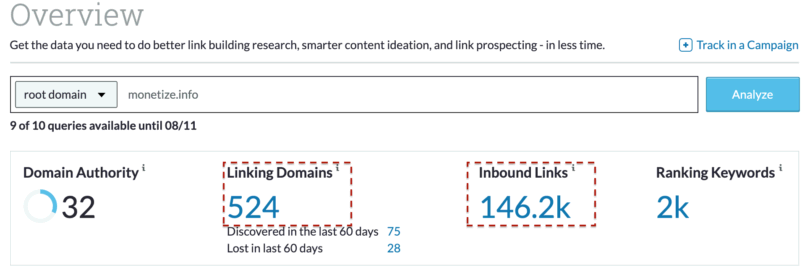
3.3.3 SEO SpyGlass (Free & Paid)
Besides all other backlinks tools we recommend, SEO SpyGlass (Check our review) is a desktop app (both Windows and Mac) that gives you accurate info. Their pricing structure is appealing.
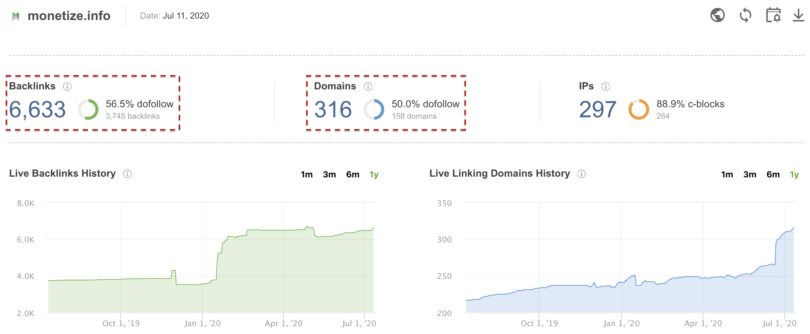
3.3.4 Ahrefs (Free trial & Paid)
Ahrefs has a good backlinks database that is updated pretty often.

3.3.5 SEMrush Backlinks (Free Trial, Paid)
SEMrush (Tutorial, Exclusive deal) is my favorite tool when it comes to analyzing backlinks. It has a comprehensive backlinks database, and it offers a link toxicity score, which makes it easy to distinguish good backlinks from toxic ones.
Other tools you can use to find competitors’ backlinks: SeoBility.net, LinkMiner from MangoTools.
3.4. Find guest-authoring opportunities
If you plan to capitalize on your knowledge asset, you should find places to share your expertise.
Search for guest authoring opportunities with queries like:
- [your keyword] guest blogging
- [your keyword] guest posts
- [your keyword] guest authors
- [your keyword] write for us
- [your keyword] looking for writers
More readings on Finding Guest-authoring opportunities:
#4. Identify Good And Bad Links
You should have at least 100 link opportunities in your Link Building Framework by finishing the last section.
Now we will qualify, organize by importance, and take out the bad links from the list.
I’m going to share 10 ways with you to distinguish good link prospects from the bad.
4.1. Domain age
No matter what Matt Cutts says about domain age, domain age is still a paramount factor in search ranking and website authority. Marketers like Neil Patel still believe in the domain age.
The older the domain of your linking prospect, the better.
This Domain Age Tool allows you to see the domain age of every domain name you type in. It works with a list of sites, so you can prospect all domain names you’ve collected in the previous chapter at once.

I would take out from my link-building campaign domains that are very new, less than one year old.
4.2. Website relevance
How relevant is the website to your linkable asset?
Look for related keywords appearing in:
- Title tag
- Anchor tags
- H1, H2, etc. tags
- URL of the web page
- In the body copy
I love using WordTracker Scout for that. Scout is a Chrome extension that gives you keyword insights for the page you are currently viewing.
4.3. Website traffic
“The best backlink is one that sends you traffic.” – Brian Dean, Backlinko
While it’s impossible to know what traffic exactly a website gets (unless you take a sneak peek into their Google Analytics), you can still have a good estimate using online tools, both free and paid.
The most accurate is SEMrush Traffic Analytics. The basic information is available in the Premium plan, while for more details, you need to purchase the addon, which costs another $200/mo. I don’t recommend it if you don’t own a digital agency or keep a very close eye on your competitors.
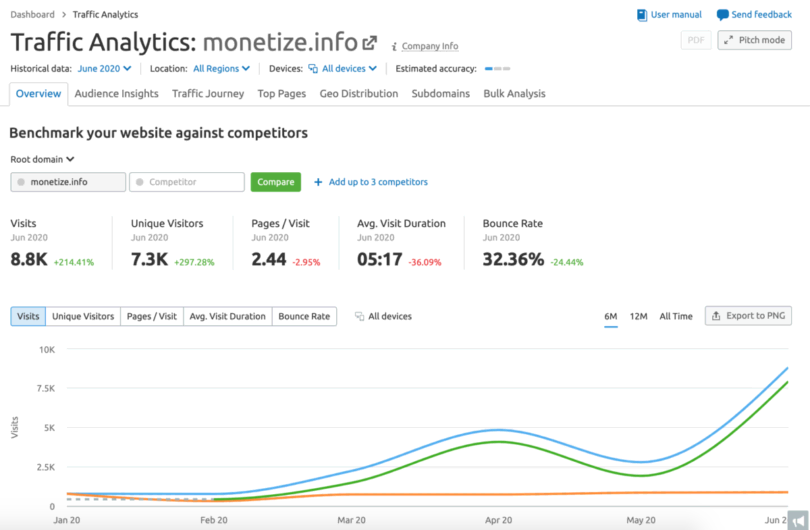
Another option you can use to get traffic information about websites is SimilarWeb. Like SEMrush, the paid version of SimilarWeb gives you more details, while the free one is pretty limited. Unfortunately, for small sites, the figures are not present or inaccurate.
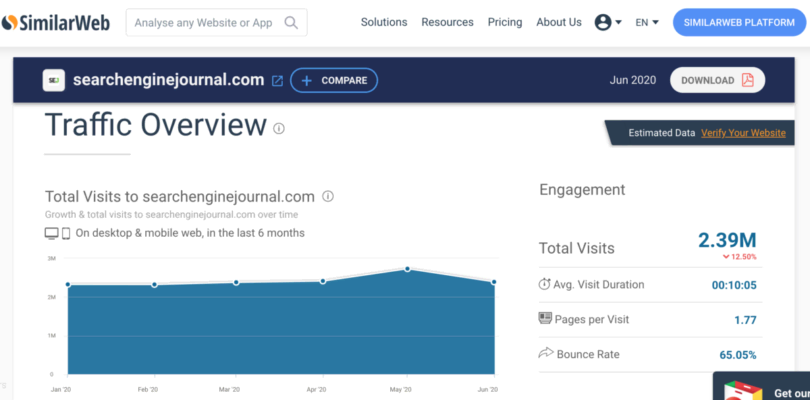
The 3rd option we recommend is the good, old Alexa.com. Again, not really accurate stats but gives you estimates that you can use to judge if the link from a website has the chance to give you traffic or not.
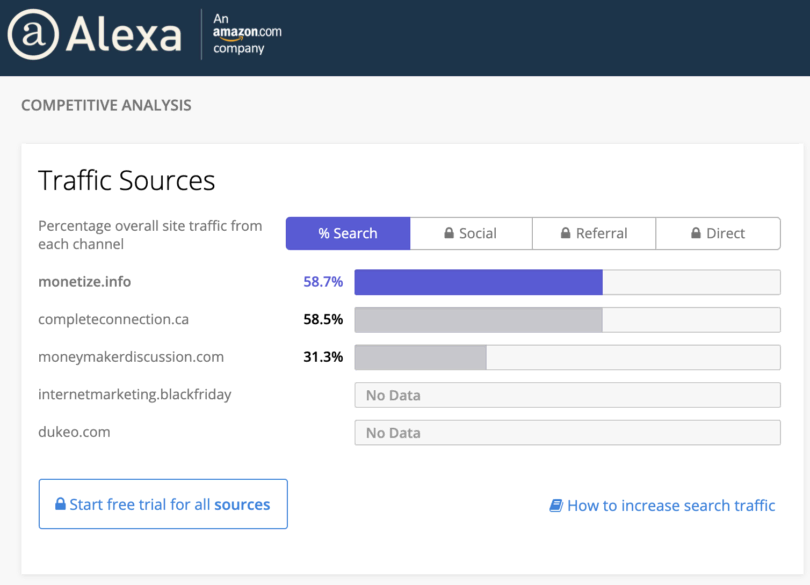
The last option we recommend is Ahrefs that just like SEMrush, has organic traffic estimation on their paid plans. To make this clear, it doesn’t have details of referrals or social media traffic, only estimating traffic from search engines.
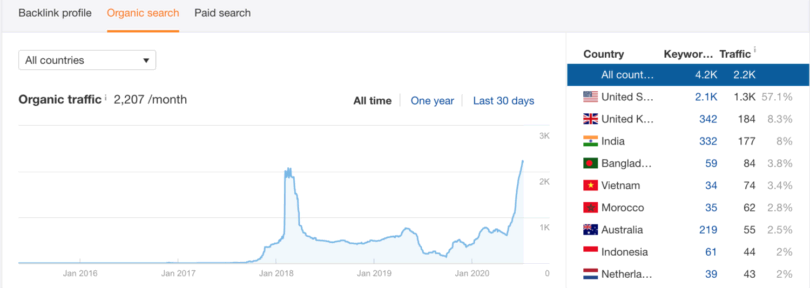
4.4. UX metrics
Remember about the importance of UX metrics for your link-worthiness. Your backlinking prospects’ UX metrics are important as much when you qualify websites.
For that, you can also use SimilarWeb. It gives you an approximate overview of a website’s Time on site, Pageviews, and bounce rate:
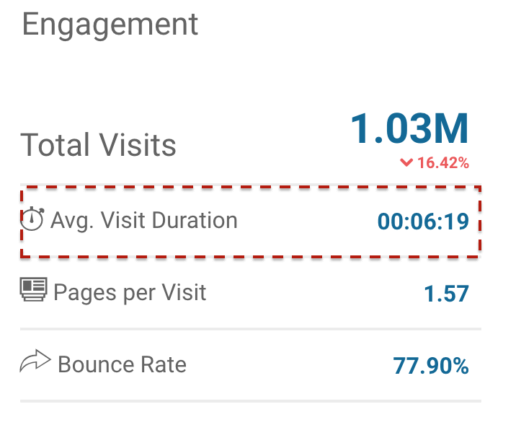
You don’t want backlinks from a website with less than a 1-minute time-on-site and above a 70% bounce rate after traffic and sales. However, these types of links can still bring SEO power to your search engine rankings.
4.5. MOZ Page Authority (PA) and Domain Authority (DA)
Domain Authority is a score (on a 100-point scale) developed by Moz that predicts how well a website will rank on search engines. Use Domain Authority when comparing one site to another or tracking your website’s “strength” over time.
The MOZ Bar Is a simple Chrome Extension that allows you to qualify an online store’s authority.

4.6. Inbound links
The quantity and quality of inbound links are significant in how a website ranks on the search engine results page. From the previous sections, you already know how to check Inbound links with the Open Site Explorer.
Several more ways
Two other quick ways to qualify competitor inbound links are:
Using the following Google search query: “link:”competitorsite.com” -site:”competitorsite.com.” This search will find all links to the competitor’s site and exclude any internal links.
4.7. Outbound links
Check what links going to outside websites are on the URL.
4.8. Social activity
Do people engage with the brand? Look for factors like:
- Likes and followers
- Shares and Tweets
- Number of comments on site
I like to use the SharesCount.com tool for social engagement analysis as it gives you a quick overview of the site’s social media impact:
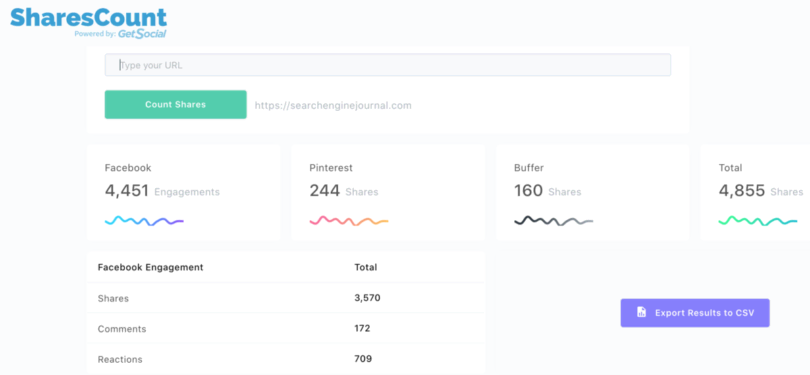
4.9. Design & Layout of the site
The website’s design and layout are the last but not the least aspect you should consider when judging a quality backlink. That’s because the design is a UX factor but speaks for the owner’s professionalism and involvement. If there are no broken elements, no broken pages, and the design is simple and clean, you may have spotted a winner.
Several other questions you should ask yourself:
- What is the overall design quality?
- Does the site use Flash or HTML5?
- Is the design accessible?
- Would users quickly access links?
- Are there excessive, annoying ad areas?
By checking these 9 factors, you should be able to separate the good from the bad links.
Don’t hesitate to remove any links from your Link Building Framework that seem obscure, lack any element of trust, or have bad inbound and outbound link profiles.#5. Monitor your backlinks
Okay, you’ve built some links but as Felix from MonitorBacklinks says: “Link building campaigns are not just about building or earning links. What’s the point if you can’t keep them? Monitoring your backlinks is just as important as building them.”
It’s important to keep your hard-earned backlinks live. Check this article to learn one way to monitor your backlinks easily using MonitorBacklinks. (Note: a paid tool.)
#6. Why you need a Backlinks audit
Any site that is seen to be participating in link schemes is in danger of a ranking loss. Even worse than that, any site that HAD participated in link schemes is also in danger.
That means if you have a site that you are now running “by the book,” but you had been involved in some dodgy link schemes in the past, your rankings could still be seriously affected if you never cleaned up those poor-quality backlinks.
To put it bluntly, Google doesn’t want you to build links to your own website, at least not links whose sole purpose is to improve your rankings. As you look through your own backlink profile, it’s important to identify links that may be causing your site problems.
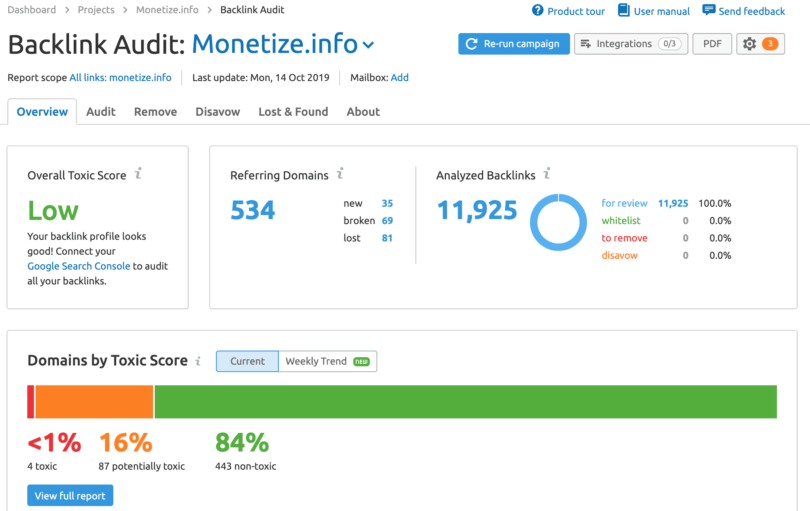
In terms of critiquing/cleaning up your backlink profile, your job is to identify your links and then clean up ALL the poor-quality ones that point to your site. The next job is to build new, better-quality links to replace the ones you’ve removed.
The first step to cleaning the links you have identified as “bad” is to contact each webmaster, in turn, asking them to remove the offending link(s). Successful or not (and in most cases, it won’t be), document every attempt you make.
Please keep in mind that backlinks audit is not a one-time job. You should do it at least every couple of months to make sure it stays healthy. Your competitors may launch negative SEO attacks and destroy your rankings if you don’t disavow the backlinks fast.
Conclusion
Good work for getting so far!
A lot of eCommerce website owners struggle with link building. This limits their SEO success because links play a big role in whether you’re successful in SEO.
But there’s no doubt about it: building quality backlinks to your store is one of THE best ways to get traffic and sales. eCommerce link building is so effective because it takes more effort than most of the other growth strategies.
But the willingness to try harder is what separates good from bad marketers.
So are you ready to get started?
 Monetize.info We Help You Grow & Monetize Your Online Business!
Monetize.info We Help You Grow & Monetize Your Online Business!

![How to build backlinks for eCommerce [The Ultimate Guide]](https://monetize.info/wp-content/uploads/2020/07/How-to-build-backlinks-for-eCommerce-The-Ultimate-Guide.webp)
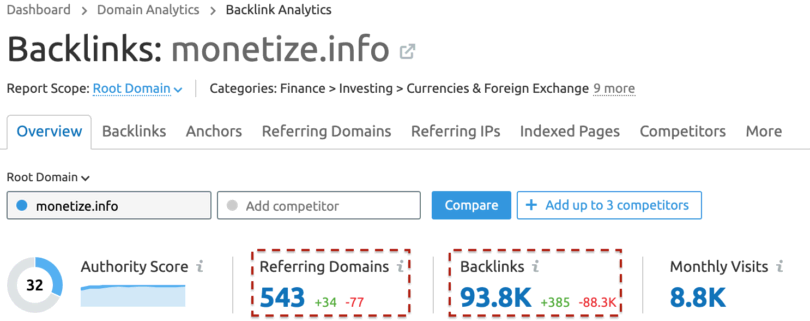




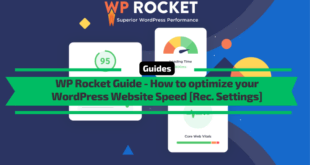

Very impressive article on bloggers. Nice and very helpful article, thanks for sharing. Thank you for sharing I just start setting up my website SEO And this helps a lot Thank you very much. Seekkr.pk, Pakistan, free ad posting, post free classified ads in Pakistan, Ads in your local area, find jobs near by you.
Nice post and very satisfying, I can find helpful informations about making backlinks and improving my SEO ranking, Thank you and keep posting.
really very useful information given by you. the article is nicely explained and easy to understand. thanks for sharing this post with us. keep your good work.
Greetings.
Was perusing the web for the daily intake of knowledge when I came across your well constructed and informative article.
Just wanted to find out how important would it be to include a blog on your ecommerce website?
Hey Good Morning,
It was geting More Knowledge and informative Blog, and thanks for the sharing this post, my point of this is more usefull for me
Good Info for Backlinks, I am Losed Some backlinks, please give me some tips what i do.
Content assets sites & open up your websites to backlinks opportunities sites.